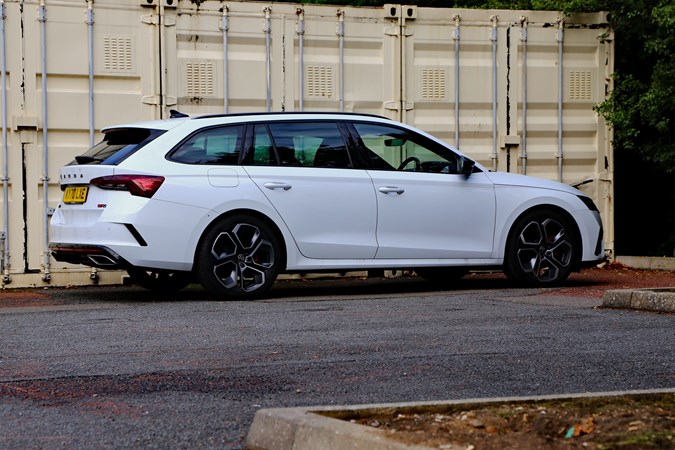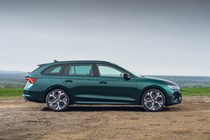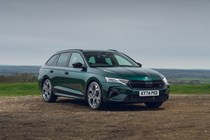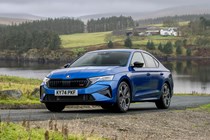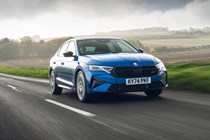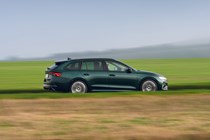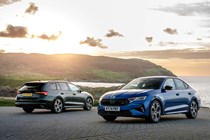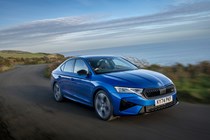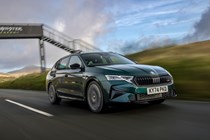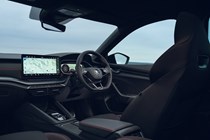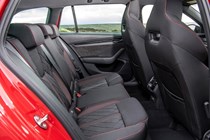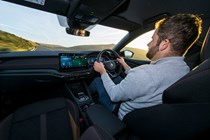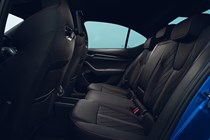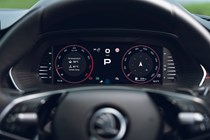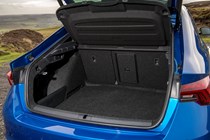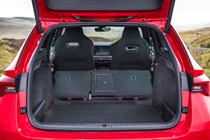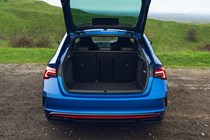
Skoda Octavia vRS long-term test
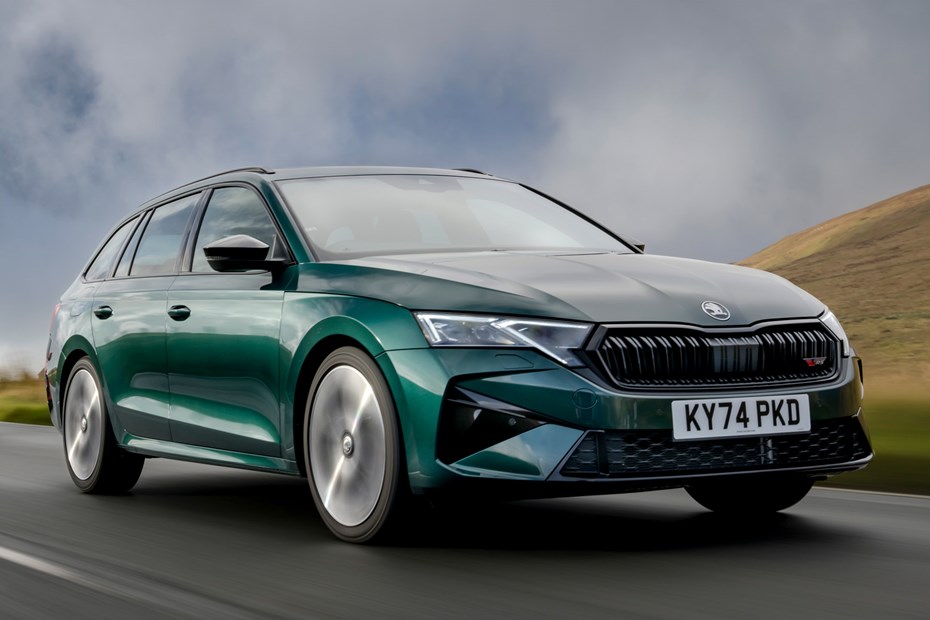
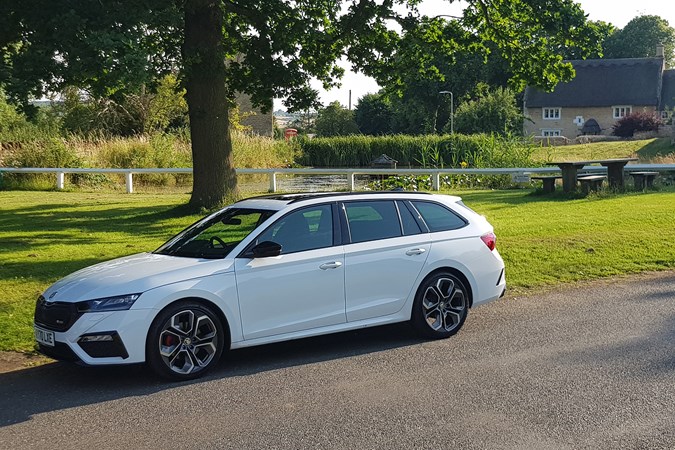
The automotive world is rushing to meet the demand for electric cars, but for many people, the best option for now is diesel. Skoda’s latest Octavia has three different diesels available – so there’s one for everyone. We’re living with the vRS 4x4 DSG to answer the question: is there life left in diesel?
Reports by Keith Adams.
Jump to:
- Cabin and controls
- 4,000-mile update
- 6,000-mile update: practicality
- 7,000-mile update: performance
- 8,500-mile update: running costs and MPG
- 10,500-mile update: changing testers
- 12,000-mile update: verdict
Update 1: Welcome
Introducing the Skoda Octavia vRS 2.0TDI DSG 4x4
The Skoda Octavia is a perennial favourite here. Not just with the staffers on Parkers, but also with the readers. And that’s no surprise considering the sheer breadth of models available and what value most of them represent. What’s also telling is that despite falling diesel sales in the UK, models fuelled this way are really important to Skoda, with models spanning 110-200hp. That’s why we’re running one for six months to see whether there’s still a case for diesel.
It’s a recent addition to the UK market and is now established as the fast-selling replacement for the 2013-2020 generation car. As before, it comes in both hatchback and estate bodystyles. We’ve already subjected the 110hp SE L 2.0TDI First Edition hatch to the long-term test treatment, so now it’s the turn of the 200hp vRS 4x4 DSG to see how it performs in our high-mileage test.
For the first time, Skoda offers the vRS in three forms – petrol (245hp), plug-in hybrid with 245hp and this diesel (200hp). Although the diesel is the least powerful and slowest on-paper, I am confident it’ll still feel lively on the road, given the 400Nm of torque it develops at a mere 2,500rpm – perfect for quiet cruising as well as muscular acceleration.
Check out the Skoda Octavia 2020- specs page on Parkers for the entire range – especially worth bearing in mind as not all engines are available for every trim.
What you get with a vRS
The vRS TDI weighs in at £34,975, and the accent is very much on sportiness. But don’t think you’re going to be going without life’s essentials, because for your money, you get a fair bit of equipment. Included as standard are:
- Adaptive cruise control
- Alcantara padded dash panel with contrast stitching
- Aluminium pedals
- Chrome exhaust tailpipes
- Climatronic dual-zone air conditioning
- Columbus satellite navigation with 10-inch touchscreen display
- Electrically operated boot
- Front and rear parking sensors with manoeuvre assist
- Front heated seats
- Full LED Matrix headlights with AFS (adaptive front light system
- Heated three-spoke leather sports multi-function steering wheel with
paddles for DSG - Keyless entry and start/stop including rear doors
- Lane assist
- LED headlights with LED daytime running lights
- Progressive dynamic steering
- Smartlink (includes Android Auto and mirrorlink)
- Sports suspension (15mm lower than standard Octavia)
- Virtual Cockpit with 10.25” display
- vRS exterior design – vRS bumpers and lip spoiler (hatch only), and
red brake calipers - Wireless Smartlink for Apple CarPlay
There are some notable absentees from that equipment list, including electrically-adjustable seats, underlining the fact this is a performance model and not a range-topping luxury one. But few people would come away from that feeling disappointed. Having said that, we added £5,000-worth of options, which we’ll go through in the next update.
Being a diesel, I’m expecting it to be economical – not necessarily in the same ballpark as the lower-powered Octavias, where gentle driving will net 70mpg-plus, but certainly somewhere north of 50mpg in typical UK driving. We’ll be putting this to the test with some long motorway days. The early signs are good that it should at least match its official Combined WLTP figure of 45.6–50.4mpg.
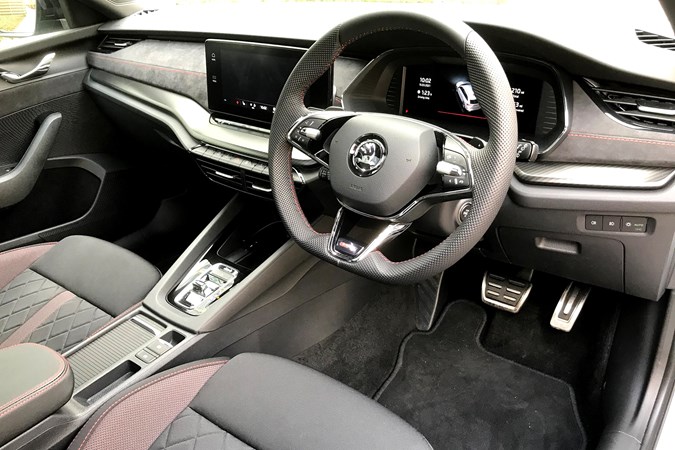
This is Skoda’s fourth generation of the Octavia and as can be read elsewhere in this review, it’s now on a par with the Volkswagen Golf sister car in pretty much all areas. It is also packed with cutting-edge tech, a huge cabin and a cavernous boot big enough to swallow anything the busiest of families are prepared to throw at it.
The interior is plush and well-trimmed with solid fittings, well-shaped seats and a dashboard trimmed in stitched Alcantara that really finishes it off nicely. So far we’ve had four people in it, and none have complained about the roominess offered, with a six-footer fitting happily in the rear behind another six-footer. An optional panoramic roof adds to the feeling of roominess by injecting airiness and bright light, which might have been an issue in this all-black interior.
Over the coming months and thousands of miles, I’ll get deep under the skin of the Octavia and be pounding Britain’s motorways in a car that combines near-150mph performance and an easy 500-plus-mile range. I can’t wait – I’ve always loved a big estate, really rate Skodas and enjoy being able to properly stretch a car’s legs on an involved and detailed long-term test.

Update 2: Cabin, equipment and options
What’s the Octavia vRS like to spend time in?
Let’s cut to the chase here – the Octavia’s interior is well put together, looks good, is roomy and is quite user friendly. And overall, I like it a lot – with the odd proviso.
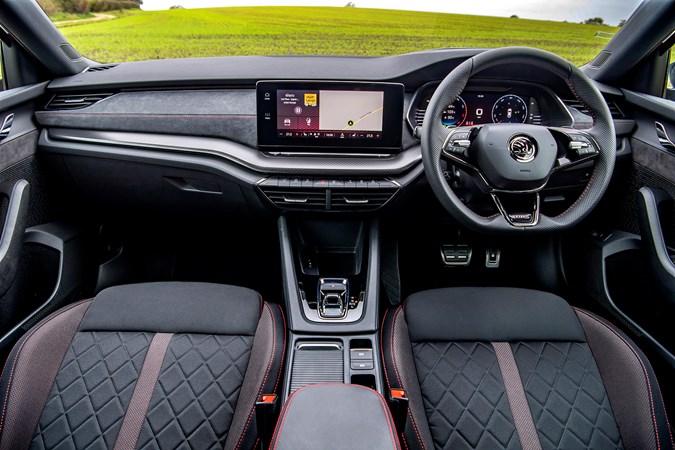
Although the Octavia is aimed at rivalling estate cars such as the Volkswagen Golf and Ford Focus it looks and feels larger, and much more of a mid-sized vehicle. This is also true in terms of quality of the fixtures and fittings, where it leads the Focus by a considerable margin, while also feeling more user friendly than the Volkswagen. Considering where Skoda has come from in the past 20 years, this is most impressive.
I touched on how well equipped the Octavia is in my last update, but it certainly bears repeating. The vRS comes with adaptive cruise control (essential these days in my opinion), rear parking sensors, 19-inch ‘Altair’ anthracite alloy wheels (that make the car look like it doesn’t have tyres), a multi-function steering wheel and dual-zone climate control. All of these combine to make the vRS very easy to live with.
The cabin is smart and everything seems to be solidly assembled, although at just over 1,500 miles in, I’ve noticed a quiet but annoying squeak coming from somewhere around the glovebox area – I will have to look into that. But it’s a cosy and very roomy place to be, and the body-hugging front seats might lack a touch of luxury, but they’re very supportive, especially on longer journeys.

Forward visibility is excellent which makes placing it in town on narrow lanes easy, and it never feels big in the way, say a Passat or Mondeo might when you’re driving in confined areas. It’s handy having the front and rear parking sensors, although I miss having a camera (am I really getting that dependent on tech these days?).
The Virtual Cockpit (above) is crisp and easy to read, and offers a number of viewing options depending on what you want. The nav view (above) is nice if you’re mid-city, but most of the time, I leave it with two-conventional dials in view overlaid by a pair of status readouts for average consumption and fuel range.
Infotainment screen
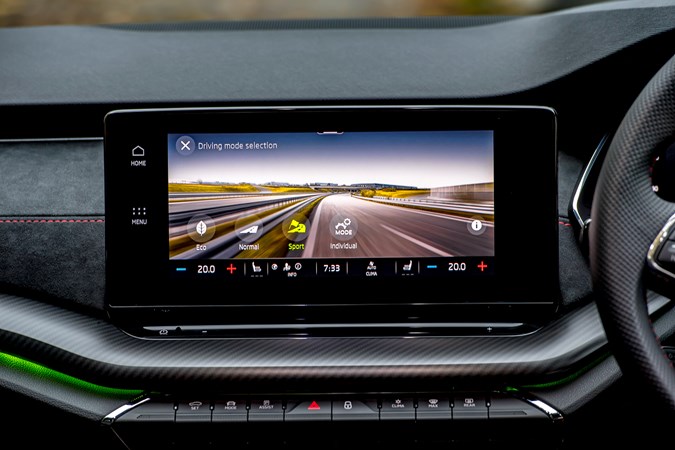
Complementing the Virtual Cockpit is this full-sized central infotainment screen. It’s a 10.25-inch display with built-in 3D navigation, and unlike previous Volkswagen Group cars I’ve driven recently, it’s quite responsive, suffering from little in the way of lag, especially once up and running and set-up the way you like it.
It’s very clear, sharp and easy to get your head round, and the only criticisms I have of it is that it’s not angled towards the driver, looks awful when covered in fingerprints and it’s mounted so high it means the fresh air vents are pushed lower down into the cabin.
The touch-screen display is responsive featuring nice, large icons and only really becomes obstructive when using Android Auto. There are lots of different menu options, but most are logical and the touchscreen seems to control almost everything from audio to the climate control. Because so many features are handled on this screen, the interior looks minimalistic, and if you want to change the volume, you’ll be limited to using the steering wheel (fiddly), the touchpad under the screen (counterintuitive) or the screen (annoying).
I miss physical buttons and knobs.
Options
I mentioned options in the last update, so here they are, pushing the vRS to nearly £40,000. After a few weeks’ driving, they’re easy to break down into worth/not worth the extra…
- Blind Spot Detection: £510
Not worth… I’d expect this as standard, and I’m okay looking over my shoulder
- Canton Sound System £590
Not worth… For a premium upgrade it doesn’t actually sound that impressive
- Dynamic Chassis Control £945
Worth it… If you’re a country dweller – agility on B-roads is really improved
- Metallic Paint/Pearlescent £595
Not worth… I keep getting clocked as a police car, which is getting tiring now
- Panoramic Sunroof £1,175
Worth it… A nice, but darkly-trimmed interior is made a whole lot airier
- Temporary Space Saver Spare Wheel £185
Worth it… You never know when you’re going to have a blow-out
- Virtual Pedal £190
Not worth… I can put things on the floor before opening the tailgate
- Total cost of car including factory fitted options: £39,165
Update 3: 4,000 miles on – how’s it going?
Skoda and I are a little over 4,000 miles in, and as a family car that covers all bases, it’s really growing on me, after a few reservations over refinement and overall driving pleasure.
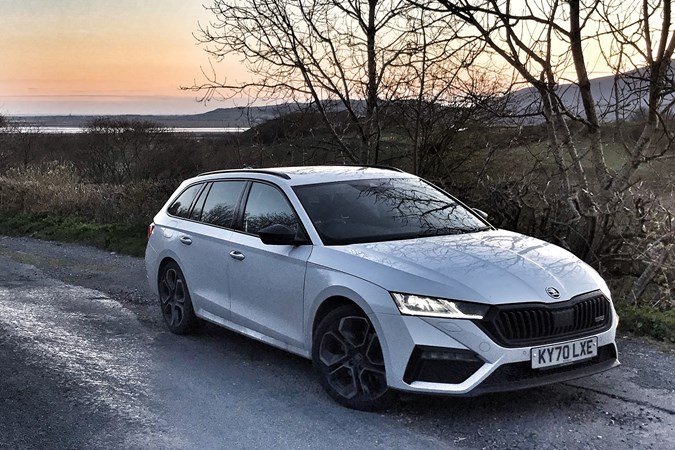
I spend a lot of time on the motorway and my first impressions weren’t that favourable. I suspect it’s all down to the fact it was replacing an Octavia SE L First Edition, which was accented far more towards luxury than the vRS is. I ended up losing a fair chunk of ride quality and motorway noise was considerably increased – both which, initially at least, made this car feel a bit of a step backwards.
But those reservations slowly subsided as the miles passed, and I came to appreciate this car’s combination of space and pace. But it’s not all about straight-line speed – its 6.8 second 0-62mph time and 148mph maximum speed are good on paper, but what they don’t convey is the ease in which the car gains speed. No drama, no fuss, no mashing of the throttle pedal – it just thunders forward with real conviction.
Enthusiasts (me included) might prefer the delivery of the petrol vRS, and the extra urge it gives you, but in reality, most of the time and on busy roads, the diesel is easy to live with. There’s noticeable diesel chatter at idle, and its grumbly, gravelly engine note doesn’t really subside until it’s drowned out by road noise, but it’s never loud, just a little unpleasant.
It sounds like an old Subaru!
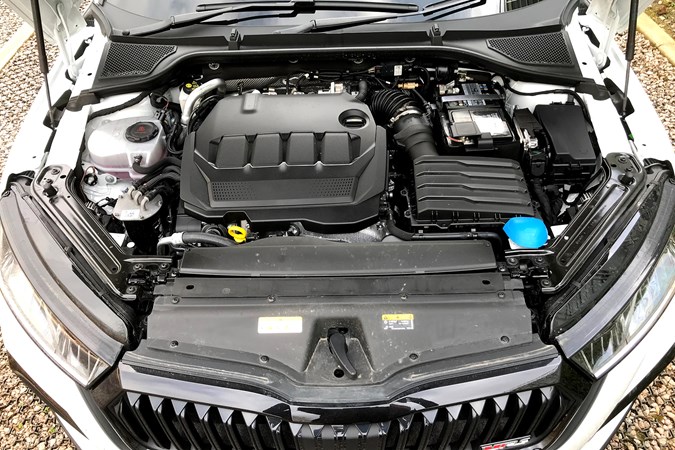
Ah yes, I didn’t mention the sound. The first time I switched on the Skoda and drove it away, I was taken aback to hear that it sounded like a cross between an old Subaru Impreza and a misfiring Ford Cortina with a blowing exhaust. That’ll be the artificial engine noise generator, then.
Pulling over and interrogating the Drive Mode settings, I soon realised that you can’t simply turn off the actuator, and have to choose a mode that leaves it switched off. So, I set it up in ‘Individual’ mode to run with Sports settings for everything, aside from the engine, which I switched to Comfort – problem solved. The car drives as it should, but without the blaring, droning accompaniment.
I mean, the diesel as it stands might not sound like honey tickling your ear drums, but at least it’s quiet. Why on earth make it sound louder and worse?
Before I leave this subject, it’s worth noting that at the start of every journey, the Drive Mode switches back to ‘Normal’ and the noise actuator comes back on. So I have to switch manually into ‘Individual’ to make it drive the way I want it – a minor but noticeable inconvenience. Also, this is a personal preference – a mate of mine who recently drove the car, loved the way it sounds…
What’s it like to drive?
For a sporting car riding on 19-inch wheels, it’s far from uncomfortable, and set-up nicely for A-roads and motorways especially. After a month and 4,000 miles behind the wheel, those reservations about its lack of refinement have washed away as my enthusiasm for its all-round usability have really come to the fore – I still wish it was a little quieter, but never has it worn me out on a longer journey.
Riding on the backroads or undulating minor roads is where the Octavia comes alive, no doubt aided by its optional Dynamic Chassis Control system, which really endows this car with agility, poise and traction. It’s well-damped, rides acceptably for a sporting car, the steering is fluid and nicely weighted, and bodyroll is kept nicely in check.
It’s not perfect, and on my first run to my home in Cumbria, it felt curiously detached on the B-roads there. But once dialled into this lack of feel and now I’m used to it, I feel it’s a car with high limits of grip that I can really trust and appreciate. Overall, it’s an enjoyable car in its own way. It doesn’t make you tingle like a petrol-powered car would, but in every other way, it’s doing a sterling job.
What have I learned so far?
My experience driving the Octavia vRS has so far has been very positive. It makes a great family car and will transport people and their luggage with ease over many miles, and at quite a speed if you want it to. Love its low-key looks, lack of drama, and ability to cover great distances while leaving you unruffled by what the world throws at you.
Stay tuned for more updates.
Update 4: 6,000 miles on – practicality
We’ve now covered 6,000 miles in the Skoda Octavia, and it’s time to turn the spotlight on this car’s practicality…
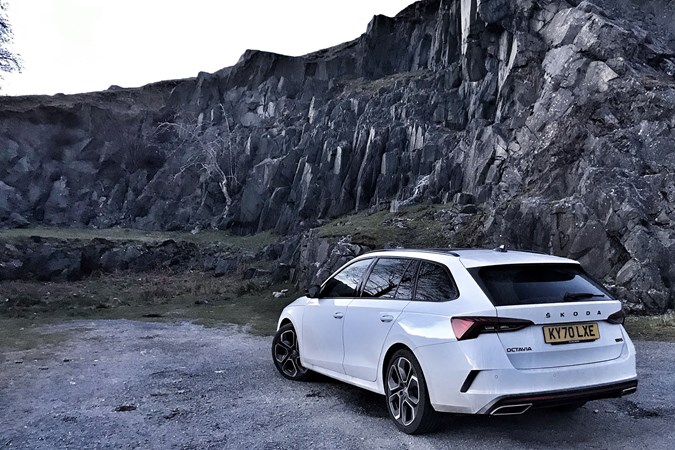
How does the Octavia Estate size-up as a family car?
So, here we are already, 6,000 miles in and I’ve finally managed to get around to writing about the Octavia’s practicality. Well, that and the diesel fuel consumption, which is good and bad. But I’ll get to that a little bit later.
Octavia Estates are generally bought for their load-lugging ability and all-round usability, and it’s one of the main reasons I’m running this car. I’ll also cover the car’s comfort before digging deeper into its practicality, as it’s definitely worth talking about.
As you’ll read in the review’s Interior section, the Octavia Estate is a very comfortable car, much more so than its predecessor. I would counter that if this is a major priority for you, you might want to forego some of the vRS’s performance and plump for an SE L instead, as there are one or two issues with this model. The seats are firm and supportive, but not averse to giving me back- and shoulder-ache on a longer run, while the road noise is rather pronounced, thanks to this car’s 19-inch wheels and low-profile tyres (below).
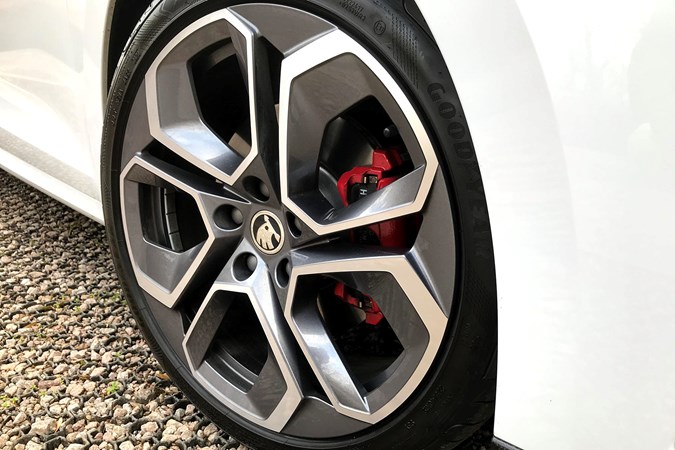
Unlike my last long-term test car – a Volkswagen Passat GTE with Ergo Comfort seats – this one doesn’t seem to be getting better with miles. It’s not actively uncomfortable, just that it’s not as restful as I’d like on a longer journey. Not that I can complain about the performance at all!
Other than these niggles, the Octavia vRS is more than up to the task of racking up miles with ease. Before I move on to the matter of its practicality, it’s worth noting that the average fuel consumption is improving right now. We’re edging closer to an average of 50mpg on predominantly motorway runs, which isn’t bad for a car with 200hp and the ability to embarrass some so-called sports cars, even if the standard diesel is considerably better.
I’m hoping that it’ll keep improving as the year unfolds.
What about practicality?
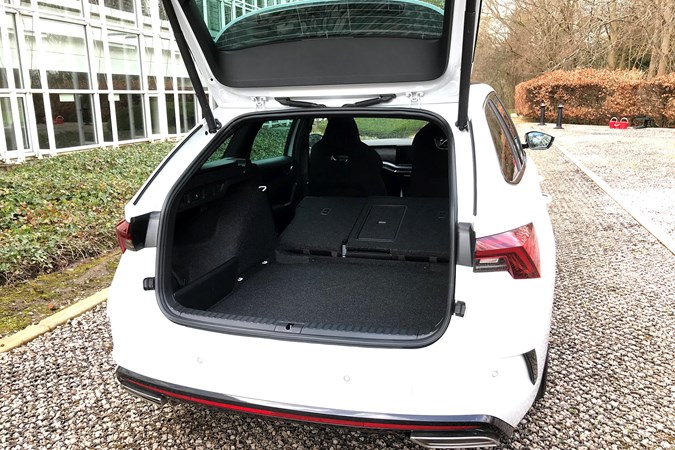
As you can see, the Skoda Octavia Estate has a large and well-shaped boot. You don’t need me to tell you that. But what is impressive is that it’s easy to forget that this generously-sized family estate is actually based on (and similarly priced to) the Volkswagen Golf. Its boot capacity is 640 litres with the seats up and 1,700 litres with them folded.
To put that into perspective, the altogether more expensive Volkswagen Passat swallows 650 and 1,780 litres, which seems like a lot of extra money for not so much additional boot space. So, it’s big, but the Octavia’s boot is also clever, with a low loading sill, a large well-shaped opening, and rear seats that fold at the pull of a single lever.
I’ve not come close to overcoming its boot capacity in the day-to-day tasks of shopping, travelling and carrying stuff to the tip as yet. I don’t expect to either. This is doubly impressive considering that it doesn’t feel big on the road when something like a Passat or Ford Mondeo might.
What about rear-seat space?
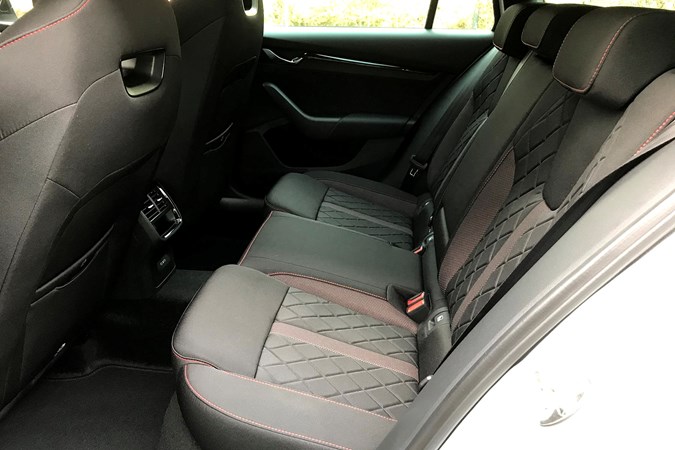
Again, this is remarkable considering the car is based on the Volkswagen Golf – a compact family hatchback. My acid test is making sure my son, who is 6ft3in, can comfortably sit behind me in the driving seat (I have it pushed back a long way) without any complaints about head or legroom. And the good news is that this car passes the family test with flying colours.
It’s difficult to think of a roomier car for this sort of money. And that includes SUVs and MPVs, which tend to sit you a little more upright than this. Sitting behind the one-piece front seat backs would normally induce a feeling of claustrophobia, but thanks to this car’s generous glass area and the panoramic glass roof, it’s actually light and airy.
Great news if you regularly carry passengers in the rear.
Update 5: 7,000 miles on – performance
Having travelled 7,000 miles in the vRS-branded Octavia diesel, it’s now time to talk about its performance…
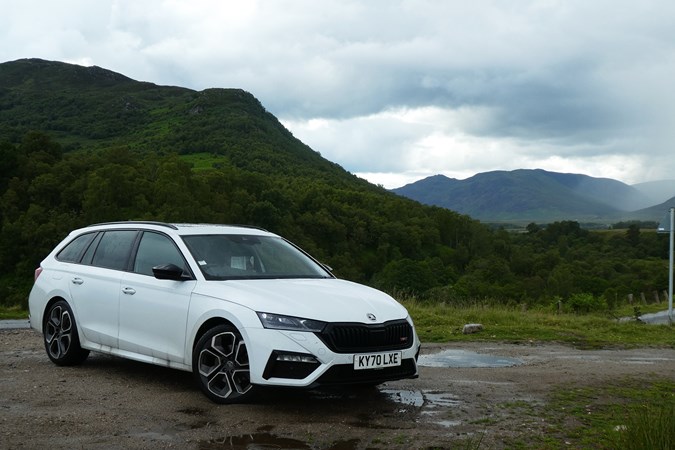
Remember when performance diesels were a thing? Even as recently as five years ago, you couldn’t move for high-performance models that fed at the black pump – cars that could combine a 500-mile cruising range, with effortless performance and a lower company car tax rate than petrol. Well, guess what, despite the industry’s relentless move towards electrification, all of the previous points are still true, it’s just that your choices are a whole lot more limited.
But Skoda knows its audience, and it remains committed to diesel, offering three different DERV-powered Octavias. The vRS is the most interesting because it combines 200hp and four-wheel drive and competes directly with petrol and plug-in hybrid siblings all offering similar amounts of performance. This says a lot about the vRS TDI, because it’s 45hp down on those two cars, but thanks to ample mid-range torque, it has all the pulling power to keep up with them.
How does it stack up as a performance car?
The answer to that question very much depends on what you’re looking for from a performance car. If it’s drama, excitement and a spectacular soundtrack, you’ll need to look elsewhere. But if – like 99% of drivers rooted in reality – you just want to get places quickly and without attracting attention, the vRS TDI will be right up your street.
In that, I think it works really well, and I’ve enjoyed making swift progress in it when I can. The claimed 0-62mph time is 6.8 seconds, but it feels far quicker than that thanks to that strong mid-range pull. It’s at its best at speed, and will devour A-roads with little fuss. On the motorway, it’s also good, where it settles down to an easy cruise, with instant acceleration should you need it. All that marks it down here is the higher-than-average amount of road noise.
What about handling?

The Octavia vRS is all about getting things done than delivering delicacy of response. In corners, it’s grippy and poised, with minimal bodyroll and sharp and responsive turn-in. It lacks the mechanical limited-slip differential you get in the petrol vRS, instead coming with an electronically-controlled system called XDS+, which applies the brakes of the inside wheel if it detects any loss of traction. In my time with the car, the system has worked very well indeed, or at least I’ve not noticed it – but then, again, with four-wheel drive, it’s going to take a lot to see it lose traction anyway.
The ride quality is stiff legged, but perfectly acceptable for a car with this much performance and agility – and thanks to my car’s adaptive damping, in Normal or Eco mode, it’s more than acceptably comfortable. Sport stiffens things up, but even then it’s no roller skate, and there’s still some ride quality to complement the car’s excellent cornering.
Any complaints?
Thanks to an intrusive fake engine noise generator inside the car, it does at least try to sound interesting, and take away some of the soft diesel clatter. Once underway, it sounds like a cross between an old Subaru Impreza and a Cortina with a blowing exhaust. It’s funny for the first few miles, but quickly becomes irritating. The good news is that you can turn it off using the drive mode selector. Annoyingly, though, you can’t switch it off permanently, as the car always defaults to ‘Normal’ mode. So you’ll have to turn it off every time.
The DSG automatic is best left in ‘D’ or ‘S’ rather than trying to use it as a manual with the steering wheel-mounted paddles. It can be slow to respond, sometimes doing nothing when you need it do. In reality, those paddles are probably there for marketing reasons and not for necessity’s sake.
It’s also a little slow getting off the line. You can probably blame that on the stop-start system, which can be a little slow to respond. Not really an issue normally, but if you’re waiting to enter a fast-flowing roundabout, you need instant response – what you don’t need is it lazily pulling into the flow…
Update 6: 8,500 miles on – running costs and MPG
At 8,500 miles it’s time to see what the Skoda’s costing us…

In terms of running costs so far, the Octavia is doing exactly what’s expected of it. It’s not been near a dealer and nothing has gone wrong or dropped off. It did report that the oil level was low at 7,800 miles, which prompted a quick trip to the local motor factor get a litre of 5w30 fully synthetic.
If nothing else, it was a timely reminder that Volkswagen Group engines like a drink, and we need to get back into the habit of checking the oil level every month! It’s not needed AdBlue, either, but does seem to need very regular screen wash refills – is the reservoir too small?
The most impressive aspect is that it’s actually matching the official fuel consumption, averaging 49.1mpg in my hands – admittedly on longer, fairly gentle A-road and motorway runs, but I’ll take that considering the performance on offer.
I’m handing the car over to finance editor Murray Scullion for a while, so we’ll no doubt be returning to this subject – but as he lives in London, expect that excellent fuel consumption to drop off a little…
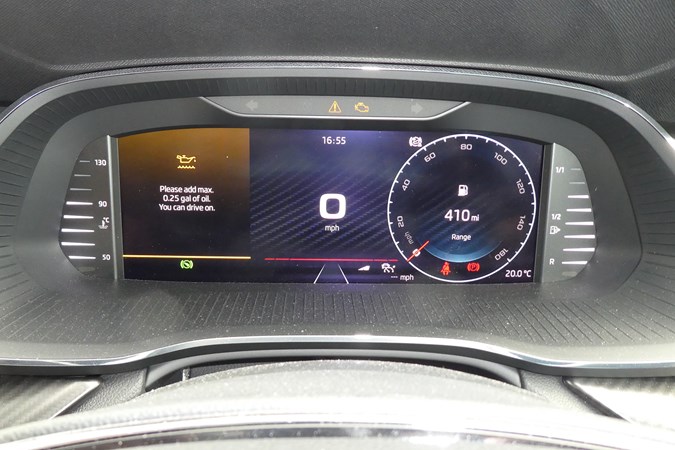
Update 7: 10,500 miles on – a fresh perspective
Murray Scullion takes over the running of our Octavia vRS

Keith helpfully put 8,500 miles on the Skoda before I received it. And as I write this, I’ve just trickled it past the 10,500-mile point. Maths fans among you will realise this means I’ve driven around 1,500 miles in the Octavia.
What have I learned? I think if you buy a vRS diesel estate expecting it to offer hot-hatch levels of fun, you’ll be disappointed. It’s the fault of the engine more than anything else.
It doesn’t zing at all. It doesn’t like to be revved. It’s just no fun. The steering is sharp and turn is decent considering the size and weight of the car. But there’s little joy in really hammering it like you would a hot-hatch.
It’s taken me a while to get my head around it, but I’ve finally figured out what this vRS is. Ignore the big wheels and faux exhausts. The diesel vRS is a brilliant family car that just happens to be fast in important day-to-day driving situations.
Overtaking on a country lane, pulling out quickly at a roundabout, setting a decent pace on the motorway. It’s a car that adds a bit of punch in day-to-day driving rather than one you’d take out for a specific drive.
Saying that, I’ve also discovered that it, like most VW cars with DSG, has launch control. It’s not found on a button or in a sub-menu. Just put it in sport, turn off the ASC, select drive, mash your left on the brake and your right on the accelerator. Lift off the brake, and away you go.
It’s genuinely brisk. And because of the Skoda’s weight, it lifts up at the front like a wayward ocean liner. I’ve no idea why Skoda has included this function but I’m really glad it has.
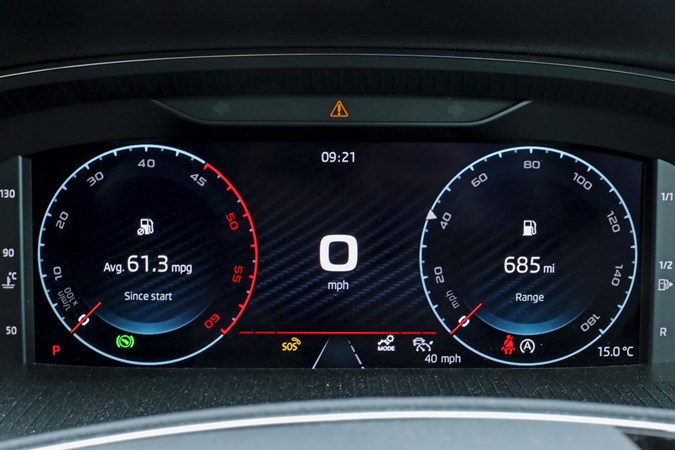
What I’m loving…
Being a millennial living in London, I very rarely actually drive in the city. Most of my travel by car is on the motorway. The vRS is stupendously good at this. Quiet, fast, and with forgiving enough suspension.
I’m also hitting close to 60mpg on the A1. Which is seriously impressive. The 50-litre tank means I’m regularly getting more than 500 miles from a fill up. I’m over the moon about this as my last long-termer was an electric Citroen e-C4 with a real-world range of 150 miles.
And what I’m loathing
I’m over the fact that this vRS isn’t really a hot-hatch. But it has a number of small foibles, the biggest of which is the infotainment. It’s slow on startup and has plenty of bugs in it. For some reason I nearly always get an alert to tell me the emergency SOS feature isn’t working.
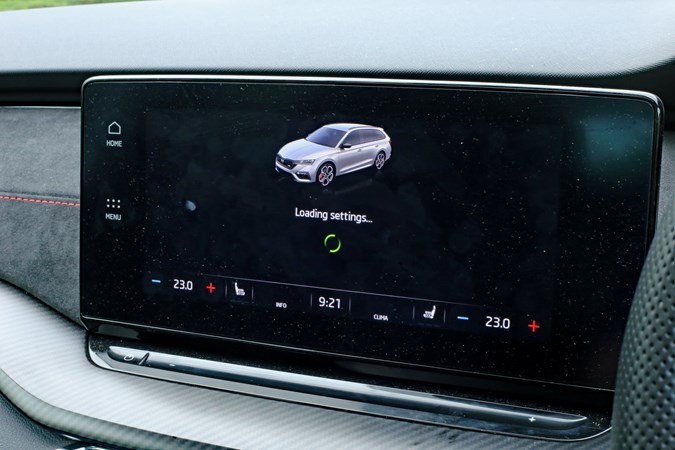
Oh and it’s performed a software update on me twice. This means when you start up the car, on the infotainment screen it just says ‘loading settings’ and won’t let you use Apple CarPlay or the radio or sat-nav until it’s finished updating. On one 30-minute journey it meant sitting in complete silence throughout the duration with nothing but my own thoughts to keep me company.
The final foible is that it doesn’t have a reversing camera. As Keith pointed out, our long-termer is close to £40,000, and I’d expect a £40k car to have one.
Update 8: 12,000 miles on – verdict
When I took the keys to this I thought a diesel performance car seemed like a silly and outdated idea.
Boy was I was wrong. Diesel may seem dirty and archaic in an age where electric cars are improving all the time, but I never ever grew tired of filling the Octavia up and the driver’s display showing me a 600-mile range.
A diesel performance car might seem like an oxymoron. And it kind of is. But after 3,500 miles I learned that you need to treat this as a kinda-fast estate, not an out-and-out performance car.
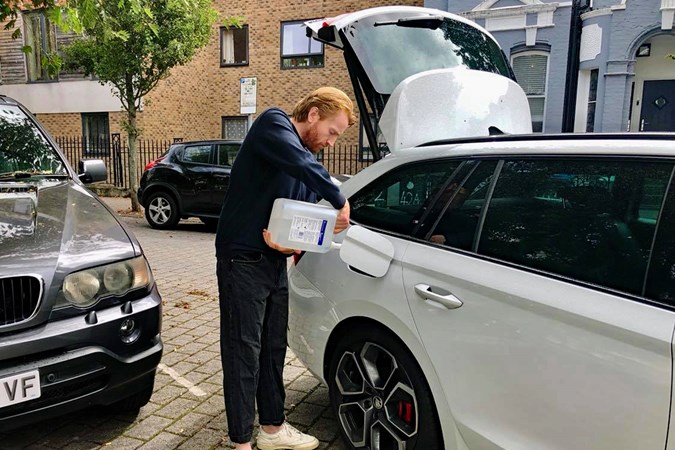
However. There have been a number of annoyances along the way that have not fixed themselves. I’ll be honest, as a tech fan they’ve irritated me greatly.
The crash-tastic infotainment grew very tiring, very quickly. As did the load times when you fired it up. I know it’s a first-world problem, but damn it when I want to go on Spotify I want it immediately.
Oh, and the adaptive cruise control. For some reason, it often slowed down when overtaking another car. For no reason.
I did at least get used to the lack of physical buttons. And I think most other people would too.
This Skoda has proved to me that diesel still has a place in cars, despite manufacturers readily ditching the black pump.
| Skoda Octavia Estate vRS 2.0TDI 4x4 DSG |
|
| Current mileage | 12,022 |
| Real-world average fuel economy | 52.8mpg average |
| Official combined fuel economy (WLTP figures) | 45.6 – 50.4mpg |
| Parkers ‘MPP’ (Miles Per Pound) calculation | 7.8 – 8.6 |
| Car joined Parkers fleet | March 2021 |
